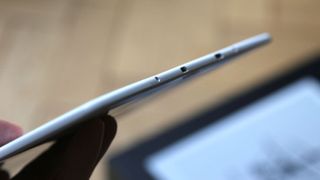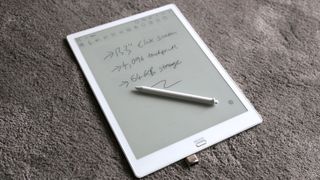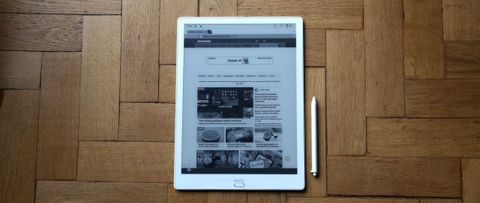TechRadar Verdict
An A4 E Ink display that supports video? The Onyx Boox Max3 is a fascinating device, though best for paperless annotating and digital note-taking, with impressive handwriting-to-text skills.
Pros
- +
E Ink display is excellent
- +
Handwriting-to-text conversion
- +
Supports Google Play apps
Cons
- -
No front light
- -
High price
- -
Not good for video
Why you can trust TechRadar
E Ink is back. And this time it plays videos. The Onyx Boox Max3 leaves nothing to chance, hardware-wise, with a huge 13.3-inch A4-size E Ink display and a stylus, so you can take notes, mark-up, annotate, and generally give your office a paperless makeover.
Built around Google’s Android 9 Pie operating system for phones and tablets, and powered by a Qualcomm Snapdragon 625 octa-core chipset, the Boox Max3 has 4GB of RAM and 64GB of storage, and comes with a USB-C to microSD card reader. It has also got 5GHz Wi-Fi and Bluetooth 4.1.
More importantly, it syncs with cloud apps like Dropbox, plays video through its web browser, and can support any app downloaded from the Google Play Store. It even reads ebooks to you, and converts scribbled notes or spoken word to text. This is serious stuff.
Is this a tablet disguised as an e-reader?
Onyx Boox Max3 price and availability
- Out now for $860 / £695 / AU$1,273
- Comes with a Wacom stylus
Costing $860 / £695 / AU$1,273, the Boox Max3 went on sale in September 2019 from the Onyx website. That price includes a customized Wacom stylus, too.

Design
- Slim but heavy
- Easy to hold and doesn't collect fingerprints
The Boox Max3 weighs 490g, which is quite a lot for an ereader. That weight is largely explained by a massive 4,300mAh battery, though it never feels particularly heavy and can be easily held in one hand by pinching one of its corners.
At 310 x 228 x 6.8mm, it’s really slim, though the bezel isn’t particularly narrow at 11mm wide. The white matte finish to the bezel and the back makes it easy to hold and doesn’t collect fingerprints.
On the bottom there's a USB-C port and, rather unusually, a mini HDMI for attaching it to a PC or Mac to act as a monitor extension. We’re not sure who’s going to want to do that, but design-wise, the Boox Max3 is nevertheless an immaculate and well-built device.

Display
- 13.3-inch 1650 x 2200 display
- 207 pixels per inch or around 3.7 megapixels
- No front light
At 13.3 inches, the E Ink Mobius display panel is a whopper. With a resolution of 1650 x 2200, the Boox Max3 offers about 3.7 megapixels of detail, or 207 pixels per inch (ppi) if you want to make smartphone comparisons (if you do, know that the Samsung Galaxy S10 has 550ppi and the iPhone 11 Pro has 458ppi).
However, more importantly, the large display is supposed to mimic the feel of paper when used with the stylus. For the most part it succeeds, as we explain in the stylus section.
Unusually for an ereader, the screen on this one also supports video, which we cover in more detail in the software section, but in short it's not going to match your phone.
It's also worth noting that there's no front light here, limiting your ability to read in the dark. And like all ereaders, the screen is black and white.

Battery life
- Massive 4,300mAh battery
- Supports fast charging
- Weeks of life without Wi-Fi
There are no problems here, with the Boox Max3’s built-in 4,300mAh battery coping with everything possible for days on end. It’s arguably too big, especially since the whole point of E Ink displays is their incredible power efficiency.
In our week-long test the Boox Max3 did dip below 50%, but only because we kept re-activating the Wi-Fi (which the software insisted on turning off at every opportunity, which was a little irritating).
The device is recharges using the USB-C slot on the bottom, and it supports fast charging.
Jamie is a freelance tech, travel and space journalist based in the UK. He’s been writing regularly for Techradar since it was launched in 2008 and also writes regularly for Forbes, The Telegraph, the South China Morning Post, Sky & Telescope and the Sky At Night magazine as well as other Future titles T3, Digital Camera World, All About Space and Space.com. He also edits two of his own websites, TravGear.com and WhenIsTheNextEclipse.com that reflect his obsession with travel gear and solar eclipse travel. He is the author of A Stargazing Program For Beginners (Springer, 2015),

New Androxgh0st botnet targets vulnerabilities in IoT devices and web applications via Mozi integration

TrueNAS device vulnerabilities exposed during hacking competition

Could this be Dell's fastest laptop ever built? Dell Pro Max 18 Plus set to have 'RTX 5000 class' GPU capabilities and Tandem OLED display
